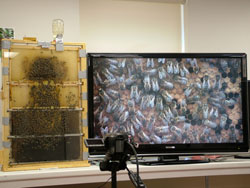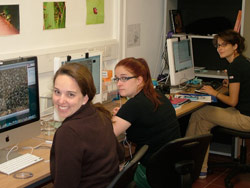Background
 Observation hive showing video recording of waggle dances
Observation hive showing video recording of waggle dances
The number of bee hives in the UK has declined by nearly 75 per cent in the past century, from approximately one million to 280,000. One major reason for this is change in land use leading to fewer flowers. Fields of wheat and barley now have few weeds. Fields of grass now have few wild flowers and clover is less used. hay meadows are increasingly rare and much of the heather moorland has been ploughed up or lost to urbanisation. To stay in business, commercial beekeepers need hives to produce reasonable honey crops. Successful honey bee foragers make waggle dances when they return to the hive. These dances tell nestmates the direction and distance of profitable flower patches. The dances can also be decoded by researchers, using observation hives and video cameras. Honey bees literally tell the researchers where they have been foraging - they are the only animals doing this. Decoding dances provide an effective means of investigating honey bee feeding ecology. Previous LASI research has shown that honey bees fly up to 14km to highly rewarding patches of heather. By decoding waggle dances we will be able to determine which parts of the landscape are good for honey bees, and how this varies in different seasons and months. This information will be of value to people who are responsible for growing plants and who want to make Britain a more bee and insect friendly country, including farmers, land managers, parks departments, and gardeners. Because honey bees are generalist foragers, foraging on plants also visited by other pollinating insects, the results of this project will help other insect species including bumble bees, other wild bees, butterflies and hoverflies.
Decoding bee dances will also be used to investigate the stress caused by moving hives. Beekeepers often move hives by truck, and it is suggested that the stress caused by moving hives can be harmful. One form of stress on the bees will be the need to “relearn” where to forge in a new location.
Main aims
To determine the habitats and distances from the hive that honey bees collect food, the plants that they visit, and to make recommendations for land use in both rural and urban areas that benefit honey bees and beekeepers.
Current status
 Margaret Couvillon, Fiona Riddell and Amanda Kuepfer decoding waggle dances
Margaret Couvillon, Fiona Riddell and Amanda Kuepfer decoding waggle dances
using iMovie on Macintosh computers
The project began in July 2009. We have now analyzed dances for August-October 2009 and March 2010. Already two interesting patterns can be seen. First, a great deal of foraging occurs in the nearby suburban area in Brighton, similar, on average to the foraging in rural areas. Second, foarging is at much greater average distances in summer (4km in August) than autumn (2km in September and October) or spring (0.7k, in March). This suggests that flowers are, in fact, quite scarce in the summer making this a season in which to target additional forage. In the spring, flowers are super abundant with crocuses, dandelions, oil seed rape and many other species blooming one after the other. Third, in August most foraging in the countryside is to a nature reserve area in the South Downs with abundant wild flowers and to pasture land with clover in addition to grass.
Personnel (past and present)
Dr. Margaret Couvillon (researcher), Fiona Riddell (masters student), Amanda Kuepfer (summer bursary student 2009), Lee Cooper (summer bursary student 2010), Suzie Johansen (volunteer), Sarah Hudson (undergraduate student volunteer 2009/10), Amanda Kuepfer, Elizabeth Harris-Jones, Laura Rozario, Samantha MacKenzie (undergraduate project students 2009/10).
Funding
The major funders of this project are the Nineveh Charitable Trust, Burt’s Bees, and Waitrose.
References
1. MJ Couvillon, R Schürch & FLW Ratnieks (2014). Dancing bees communicate a foraging preference for rural lands in High Level Agri-Environment Schemes. Current Biology 24(11), 1212-1215.
2. MJ Couvillon, FC Riddell Pearce, C Accleton, KA Fensome, SLK Quah, Esme Taylor, and FLW Ratnieks (2014). Honey bee foraging distance depends on month and forage type. Apidologie DOI: 10.1007/s13592-014-0302-5.
3. MJ Couvillon, KA Fensome, SLK Quah, & R Schürch (2014) Summertime blues: August foraging leaves honey bees empty-handed. Communicative and Integrative Biology, 7 (1) e28821:1-2.
4. MJ Couvillon, R Schürch & FWL Ratnieks (2014) Waggle dance distances as integrative indicators of seasonal foraging challenges. PLoS One, 9 (4), e93495.
5. R Schürch, MJ Couvillon, D Burns, K Tiasman, D Waxman, & FLW Ratnieks (2013). Incorporating variability in honey bee waggle dance decoding improves the mapping of communicated resource locations Journal of Comparative Physiology A 199, 1143-1152.
6. FC Riddell Pearce, MJ Couvillon, FLW Ratnieks (2013) Hive relocation does not adversely affect honey bee (Hymenoptera: Apidae) foraging. Psyche 2013, 1-8.
7. R Schürch & MJ Couvillon (2013). Too much noise on the dance floor: intra- and inter-dance angular error in honey bee waggle dances. Communicative and Integrative Biology 6 (1)
8. H Al Toufailia, MJ Couvillon, FLW Ratnieks, C Grüter (2013) Honey bee waggle dance communication:signal meaning and signal noise affect dance follower behavior. Behavioural Ecology and Sociobiology 67, 549-556.
9. MJ Couvillon, FC Riddell Pearce, EL Harris-Jones, AM Kuepfer, SJ Mackenzie-Smith, LA Rozario, R Schürch, & FWL Ratnieks (2012). Intra-dance variation among waggle runs and the design of efficient protocols for honey bee dance decoding. Biology Open 1, 467-472.
10. MJ Couvillon (2012). The dance legacy of Karl von Frisch. Insectes Sociaux 59 (3), 297-306.
11. MJ Couvillon, HLF Phillipps, R Schürch, & FWL Ratnieks (2012) Working against gravity: horizontal honeybee waggle runs have greater angular scatter than vertical waggle runs. Biology Letters 8 (4), 540-543.
Submitted:
Garbuzov, M., Schürch, R., Couvillon, M. J. C., Ratnieks, F.L.W. Honey bee dance decoding shows limited foraging on oilseed rape, a potential source of neonicotinoid contamination. Agriculture, Ecosystems & Environment (accepted)
Balfour, N. J., Fensome, K. A., Samuelson, E. E. W., Ratnieks, F. L. W. Following the Dance: Ground survey of flowers and flower visiting insects in a summer foraging hotspot identified via honey bee dance decoding.
Couvillon, M. J., Alton, K., Walter, C., Czaczkes, T. J., Ratnieks, F. L.W. Busy bees: bees visit more flowers per minute than other types of flower-visiting insects.
Couvillon, M. J., Ratnieks, F. L. W. Environmental consultancy: using honey bee waggle dances as a bioindicator to evaluate landscape “health”.
Ratnieks, F. L. W., Schürch, R. The information content of the honey bee waggle dance.
Ratnieks, F. L. W., Shackleton, K. Does waggle dance communication enable honey bees to forage at greater distances?
Popular Journals:
Waggle dance decoding BBJ 1-17 [PDF 1.60MB]
A summary of Reference 1. can be found here:
https://theconversation.com/follow-the-bees-dance-to-find-landscapes-green-hotspots-27004


